by tmoffett | Sep 10, 2010 | Black and White, Landscape, Photo tips
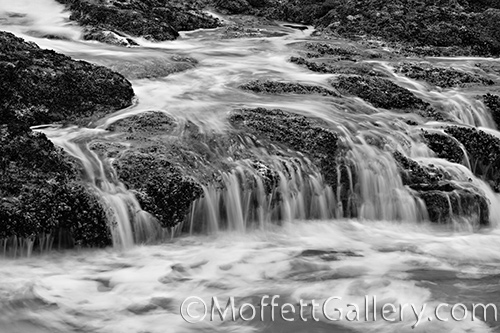
Shoreline, Yachats, Oregon
The evening we arrived in Yachats we were met with rain, however that did not stop me from photographing. We climbed out on the rocky shelf overlooking the sea and watched the waves come in. It was quite a spectacle. The waves would crash into the rock and spray seawater everywhere. The water would rush up on the shelf and then slowly retreat to the ocean just in time to meet the next wave. I photographed the waves for a while and then turned my camera inland and watched and photographed the retreating water. It appeared as a river flowing downstream and over small falls. As I photographed, Christeena was holding an umbrella, not knowing which way to hold it. Should she keep the rain off of me and the equipment of protect me from the ocean spray? It didn’t matter. Either way I got wet!
I often have students say they couldn’t photograph because of inclement weather. I only need to show them a few images and they realize that they are only making excuses. Some of my best photographs have been made during stormy weather. Students quickly learn that I won’t accept excuses of this kind, as I know, and they soon learn, that great opportunities are missed by not photographing during a storm. They just need to find a way to keep their gear dry and protected. This can be accomplished quite easily with an umbrella or even a garbage bag. When that is accomplished, a whole new world of creativity and opportunity are opened up. I love a good storm.
by tmoffett | Sep 8, 2010 | Black and White, Composition, Landscape, Photo tips
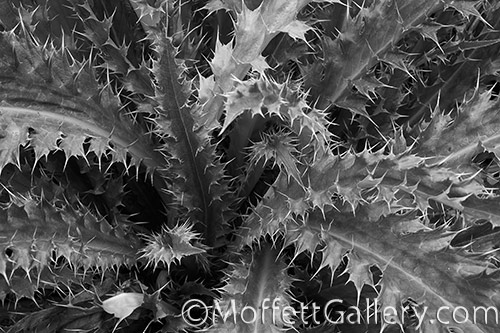
Untitled
When working in black and white, there are many factors to consider while making the photograph. Tonal range, local contrast and composition to name a few. Usually the overall tonal range should go from a deep black to bright white while maintaining good detail throughout. If the exposure is off at all, loss of detail on one end of the scale or the other becomes a problem. Light quality is ever important in creating images with a great tonal range. Once the overall tonal range is established, local contrast, the contrast between to adjacent objects in the image, must be controlled. In the darkroom, I control this by using different grades of paper. With digital, I use curves adjustment layers with layer masking. When everything is just right you will end up with a print with rich tones and great detail.
Composition is another whole ball game. In the above image, line, repetition, texture and rule of thirds are all important. They work together to lead the viewers eye from the outside down inside the plant. While traveling down the plant, every prickly point is rendered in rich detail. I begin to feel the image. I know I do not want to touch it. It is sharp and prickly. the eye is led to the lower left quadrant, off center just enough to create interest.
I love black and white. Quality black and white photography is becoming a lost art. Digital cameras have made it too easy that we forget at times to slow down and think before pressing the shutter. Shooting by instinct is great, but first learn technique so that when shooting by instinct or feeling you get the tones and composition right. It will improve your photography, I promise!
by tmoffett | Sep 6, 2010 | Color, Landscape, Photo tips, Photographic Philosophy
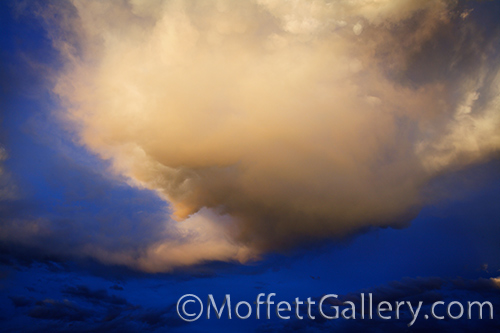
Cloud Formation
Remember the days as a kid spent laying on your back watching the clouds blow by? Those were the days! Not a worry in the world. Just kick back and enjoy the summer. Sometimes I wish I could go back to those days. And then I think again. I like where I am and where I am headed, so I guess I wouldn’t change a thing. Life is good.
Photography is my outlet. I say what I feel through my images. I have learned to manipulate the camera to capture feelings along with the image, or should I say embed in the image. To some viewers, it may just be a picture, but to others it exudes feeling and meaning. This happens because I shoot from the heart. I don’t think when I photograph, I feel. I have tried to make technique a part of my nature so I do not have to think about it when I photograph. It comes naturally. I focus now on interpretation of a scene. I find that if I think too much, then I end up with boring images that have no meaning, to me or anyone else.
Learning technique takes time. It takes practice. I remember taking a Zone System class in college. Everyone seemed to hate it because it was too technical. It did not allow for the art to come through. It was difficult and grueling. We photographed towels and analyzed the density of the film and prints. It was boring. I stuck to it and learned. It was all about technique. Looking back, I don’t think that I learned more in any other class or workshop that I have taken since. That class is where technique became second nature for me. It allowed the art within me to be released. As a landscape photographer that is critical if I want my images to have meaning.
I guess what I am saying is this:
Learn the technique.
Pay the price (time and practice).
Enjoy the result.
by tmoffett | Sep 1, 2010 | Color, Landscape, Photo tips
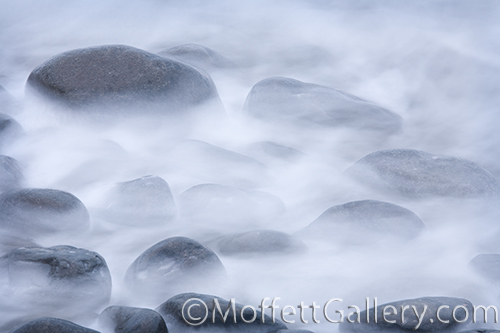
Rock and Water
I love the ocean, and one of my favorite places to visit the ocean is along the Oregon coast. The opportunities for incredible photographs are endless. It makes no difference what the weather is like, imaging opportunities are abundant. The variety of coastline scenery is unreal. You can walk from the sandy beach to tidepools to rocky outcroppings to a rain forest in just a matter of minutes. I don’t think I could ever get bored.
One evening while watching the sun set in the western sky, I began watching the waves wash in over the rocks near the beach. The water would come in and wash over the rocks and then flow back out to the sea. It was quite mesmerizing. As I sat and watched, I turned my lens away from the sunset and began photographing the water. Capturing the motion of the water made the rocks appear soft and pliable. The water became almost a mist, a cloud upon which the heavy rocks floated. Instead of the feeling of hard, heavy, black stones, a light and airy feeling prevailed. I liked that. It emulated my feelings at the time. I was in one of the most beautiful places on the planet, sharing time with my wonderful wife and creating photographs. What could be better?
Not much.
by tmoffett | Aug 26, 2010 | Photo tips, Photographic Philosophy
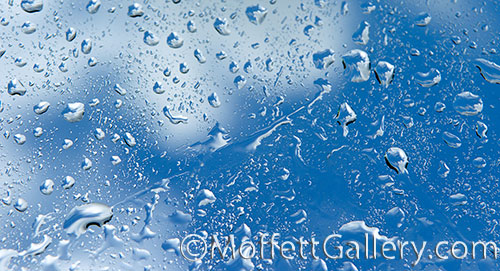
Wet Outside
“It’s cold outside.”
“It’s raining and I don’t want to get the camera wet”
“I didn’t have time.”
The world is filled with excuses. I teach photography to high school students and I hear excuses every day. I am amazed that I hear these same excuses occasionally from “Professional” photographers as well. This is one area that needs to be corrected if we are truly going to find success.
I have learned that changing an excuse into an opportunity is simply a change of mindset. When it is raining outside I find the opportunity to create images that I cannot get when it is dry and sunny. Protecting the camera is a simple thing. It can be done with a garbage bag! When it is cold and snowy, put on a coat and gloves! There are photographs to be made that those lazy photographers will never even see, except when they view yours!
In the photograph above, for instance, a thunderstorm caught me off guard and I retreated to the truck. While waiting for it to pass I continued searching for a photo opportunity. I found this just before the sun broke through at the end of the storm. I know it is not a masterpiece, but it was a great exercise in looking for images, and it made me aware that no matter where we are or what the weather is, there is always photos waiting to be created.
Be looking for opportunities at all times. I guarantee it will make a difference.
by tmoffett | Aug 19, 2010 | Black and White, Landscape, Photo tips, Photographic Philosophy
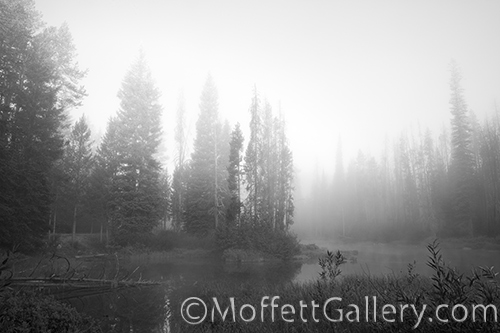
Early Morning in the Sawtooths
The Sawtooth Mountains are one of my favorite places to visit. The cool, fresh morning air makes waking up a pleasure. The scenery is incredible, especially first thing in the morning. Saturday I had the pleasure of being at Alturas Lake at sunrise. We had a light fog that created a mood and feeling that was calm and relaxing. It was wonderful just to be there and enjoy Gods creations. What made it even better was being able to photograph the experience.
What do I look for when I am out with my camera? How do I find the right subjects to photograph? I am asked these questions on occasion. I have thought about what I do and how I do it so that I can accurately answer. While out photographing I tend to not only look with my eyes, but also with my heart. I try to feel what is happening around me. What mood is surrounding me? When I feel something I get out the camera and try to produce the feeling in an image. Not always an easy task but always a worthwhile endeavor. By searching for feeling an image with deeper meaning is created. It is not just a pretty picture, it becomes a piece of art.








Recent Comments